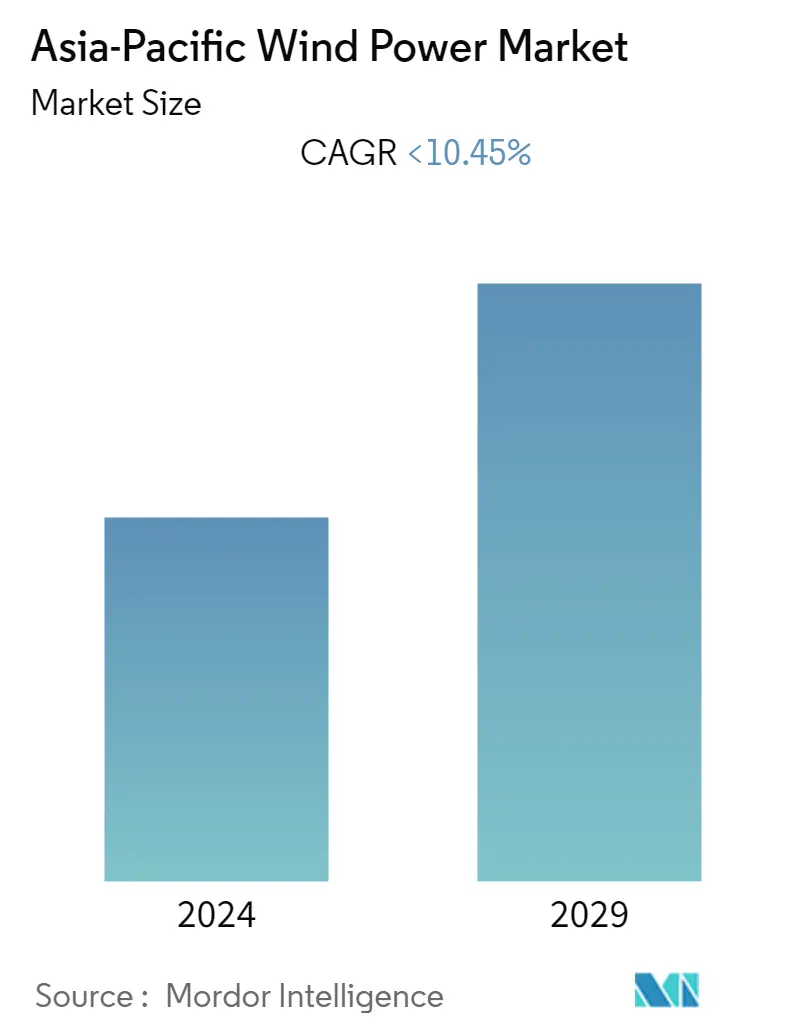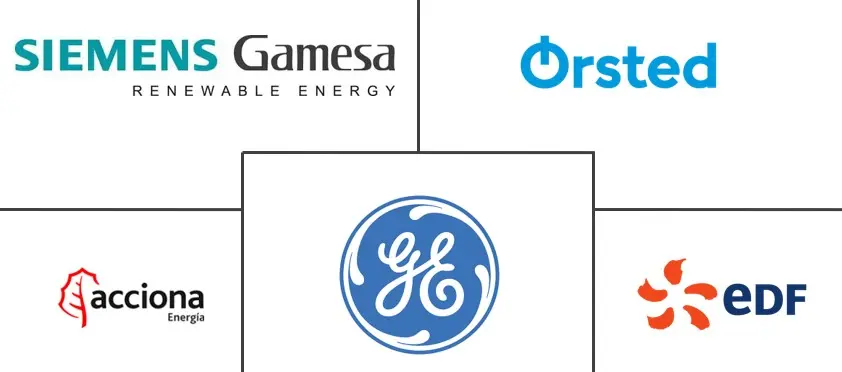Market Size of Asia-Pacific Wind Power Industry

| Study Period | 2021 - 2029 |
| Base Year For Estimation | 2023 |
| Forecast Data Period | 2024 - 2029 |
| Historical Data Period | 2021 - 2022 |
| CAGR | < 10.45 % |
| Market Concentration | Low |
Major Players
*Disclaimer: Major Players sorted in no particular order |
Asia-Pacific Wind Power Market Analysis
The Asia-Pacific Wind Power Market is expected to register a CAGR of less than 10.45% during the forecast period.
The market didn't have any significant impact due to COVID-19 in 2020. Presently the market has now reached pre-pandemic levels.
- Over the long term, major factors attributing to the growth include favorable government policies, the increasing investment in wind power projects, and the reduced cost of wind energy, which led to increased adoption of wind energy, thereby positively contributing to the demand for wind energy.
- On the other note, the increasing adoption of alternate energy sources, such as gas-based power and solar power, is likely to hinder market growth.
- The technological advancements in efficiency and decrease in the production cost of offshore wind turbines are expected to create ample opportunity for the market players in Asia-Pacific.
- China dominates the wind power market and remains the largest onshore market with 21.2 GW of new capacity additions. The government policy and incentives made China a favorable hotspot for investment; therefore, the wind power market is expected to flourish in the coming years.
Asia-Pacific Wind Power Industry Segmentation
Wind power is usually generated using a wind turbine. Wind turbines are mechanical systems that convert kinetic energy into electrical energy.
Asia-Pacific Wind Power Market is segmented by onshore and offshore. The report also covers the market size and forecasts for the Asia-Pacific Wind Power Market across the major countries. For each segment, the market size and forecasts have been done based on installed capacity in gigawatts (GW).
| Location | |
| Onshore | |
| Offshore |
| Geography | |
| China | |
| India | |
| Japan | |
| South Korea | |
| Australia | |
| Rest of Asia-Pacific |
Asia-Pacific Wind Power Market Size Summary
The Asia-Pacific wind power market is poised for significant growth, driven by favorable government policies, increased investments, and the declining cost of wind energy. These factors have led to a surge in the adoption of wind energy, bolstering demand in the region. Technological advancements, particularly in offshore wind turbines, are expected to offer substantial opportunities for market players. China stands out as a dominant force in the market, with its extensive onshore wind capacity and supportive government incentives making it a prime destination for investment. Despite the competition from alternative energy sources like gas and solar power, the wind energy sector in Asia-Pacific is anticipated to thrive, with onshore wind power generation technology evolving to enhance efficiency and expand coverage to areas with lower wind speeds.
China's commitment to increasing its renewable energy share, particularly wind power, is evident in its ambitious plans and projects. The country aims to significantly boost its wind power capacity as part of its national energy strategy, addressing pollution from thermal energy sources. With substantial installations in wind-rich provinces and plans for large-scale projects, such as the world's largest wind farm, China is set to maintain its leadership in the Asia-Pacific wind energy market. The market is moderately fragmented, with key players like Acciona Energia SA, Orsted AS, EDF SA, General Electric Company, and Siemens Gamesa Renewable Energy actively participating. Collaborative efforts, such as partnerships for offshore wind power development in India, further underscore the region's dynamic growth prospects in the wind energy sector.
Asia-Pacific Wind Power Market Size - Table of Contents
-
1. MARKET OVERVIEW
-
1.1 Introduction
-
1.2 Installed Capacity and Forecast in GW, until 2027
-
1.3 Recent Trends and Developments
-
1.4 Government Policies and Regulations
-
1.5 Market Dynamics
-
1.5.1 Drivers
-
1.5.2 Restraints
-
-
1.6 Supply Chain Analysis
-
1.7 Porter's Five Forces Analysis
-
1.7.1 Bargaining Power of Suppliers
-
1.7.2 Bargaining Power of Consumers
-
1.7.3 Threat of New Entrants
-
1.7.4 Threat of Substitutes Products and Services
-
1.7.5 Intensity of Competitive Rivalry
-
-
-
2. MARKET SEGMENTATION
-
2.1 Location
-
2.1.1 Onshore
-
2.1.2 Offshore
-
-
2.2 Geography
-
2.2.1 China
-
2.2.2 India
-
2.2.3 Japan
-
2.2.4 South Korea
-
2.2.5 Australia
-
2.2.6 Rest of Asia-Pacific
-
-
Asia-Pacific Wind Power Market Size FAQs
What is the current Asia-Pacific Wind Power Market size?
The Asia-Pacific Wind Power Market is projected to register a CAGR of less than 10.45% during the forecast period (2024-2029)
Who are the key players in Asia-Pacific Wind Power Market?
Acciona Energia SA, Orsted AS, EDF SA, General Electric Company and Siemens Gamesa Renewable Energy are the major companies operating in the Asia-Pacific Wind Power Market.

